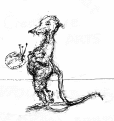One of the more intriguing articles I read recently pertains to AI generated art. The whole article is
here on artnet.com; the tl;dr version boils down to the (apparent) fact that computer generated art comes across to many as more human than human generated art. At least the stuff one finds in Big Art expositions, like Art Basel, and AbEx.
Where things get interesting, however, is when respondents were asked to rate how intentional, visually structured, communicative, and inspiring the images were. They “rated the images generated by [the computer] higher than those created by real artists, whether in the Abstract Expressionism set or in the Art Basel set.”
I don't want to get into the pro's and con's of the work; after all, it basically is just a study of commercially driven art versus AI generated art as interpreted by Mechanical Turk users. Hardly a recipe for scientifically sound generalizations. But I think it does provide an interesting counterpoint to an aspect of art that very few people talk about these days.
That aspect is resonance. What do I mean by this? For a full development, I suggest one dash out and get Jan Zwicky's book,
Lyric Philosophy [Amazon.com] and read it. I know that's how many of the formal ideas crossed my path, after Hanna GZ recommended to me several years ago. It's a relatively novel presentation, but the ideas have permeated thought for a very long time. For example, look at Nietzche's
The Gay Science, Section 373, which I added to this site a few years ago.
Most are familiar with physical examples of resonance. If you have two similarly tuned violins, and pluck a string on one, the same string on the other will vibrate. When you push a person on swing in time with its natural oscillation, and the swing goes higher. Or for a little fun, jump in the bath, start sliding back and forth in a rhythm that makes the water eventually slosh out of the tub. Kind of like the Bay of Fundy, with you as the gravitational drivers.
So what is resonance in art? It occurs, or rather can occur, on many different levels. Start with everyday experience. Go to a beach or a hill or a park, where you can just let the quotidien world fall away. Or sit quietly with bit of music, or poetry, or a painting. It can take a little practice, but with a little luck you find yourself feeling more present, more attuned, more aware. And with a little more luck, imagination - timidly at first - begins to leave its cage.
Rilke's panther can go free, if we choose.
Imagination is the set of mental metaphors we create in response to the resonance between aspects of our inner and outer worlds, between our unconscious and conscious minds. The physical expression of those metaphors is what becomes art.
(to be continued....)














